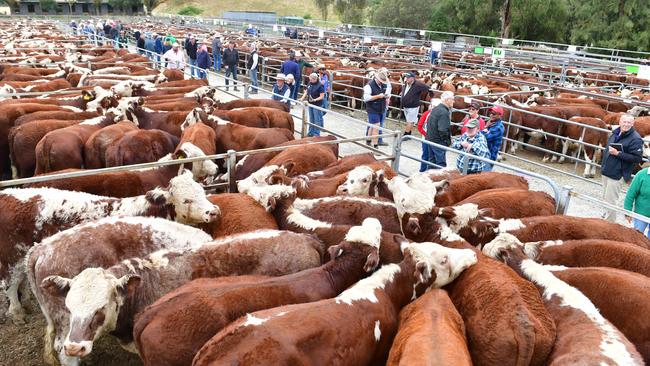Cattle prices falling but exports and inflation mean beef won’t follow
Cattle prices have fallen to their lowest in two years but a resurgent export market and inflation is limiting cheaper beef prices in butcher shop windows.

Beef steaks, fillets and sausages are unlikely to get any cheaper for shoppers in coming months, despite cattle prices tumbling on the back of strong growth in the national herd.
Retail beef prices have eased slightly since last year, but a resurgent export market, inflation and high input costs for meat processors are limiting the flow-on effect of falling cattle prices to butcher shops.
The Eastern Young Cattle Indicator, a barometer for Australian cattle prices, has dropped from historic highs of 1167c/kg in late 2021 to 681c/kg. Heavy steer and processor cow prices are also down about 25 per cent on last year.
Sydney butcher Ardi Edgu said the lower production costs were not filtering down to his customers, as producers were more focused on overseas markets than local shops such as his.
“When I speak to my wholesalers directly, they’re like ‘You just have to wait because the export market is so strong, we have to allocate that first’,” Mr Edgu said. “I’ve been waiting for a wagyu cut for four weeks now.
“Once they have enough and have accommodated the export market, they’ll get me the box.”
Mr Edgu said farmers and producers were telling him a different story.
“One said ‘Look, meat prices are going to come back. The production, the numbers are good. We have enough cattle, so it should come down.’ But it’s not coming down, that’s where the problem is.”
A key reason for the cattle price drop is greater supply in saleyards, with the national cattle herd expected to hit 28.8 million this year after graziers stocked up in response to consecutive good seasons. Meat processors, who weathered thin margins for most of the past year, are recouping some costs while battling labour shortages and high input costs.
Export markets are growing as importers from South Korea, China and Japan show renewed interest in Australian beef as prices become more competitive.

“The reason prices were sent to record highs last year was there was good weather around and there was restocking demand, so producers were buying young cattle to put on the grass they had,” Meat and Livestock Australia market information manager Stephen Bignell said.
“As that herd has grown, stocking rates and capacity max out and there’s less demand from farmers to buy animals.”
Skyrocketing prices have driven processor costs up and export levels down, leading to the lowest national cattle slaughter in 37 years. The long-term slaughter average is 7-8 million cattle; in 2022, it dropped to 5.85 million. That number is expected to rise 13 per cent to 6.6 million this year.
Mr Bignell said the export market meant more cattle supply and lower domestic cattle prices did not always equate to cheaper retail beef. “It’s not necessarily ‘livestock prices down equals retail prices down’, because the export price is a significant component in what’s happening in retail,” he said.
The EYCI is yet to drop below its 10-year-average of 621c/kg, but analysts say long-term inflation means beef prices are unlikely to return to previous lows.
Rural Bank Agricultural Analyst Michael Curtis said Australian Bureau of Statistics Consumer Price Index data showed that from 2018 to 2022, cattle prices in saleyards doubled in price, while beef prices within CPI only increased by 39 per cent.
“Basically they (beef prices) continued their steady upward trend we’ve seen for a while, about 6 to 7 per cent,” Mr Curtis said.
“We probably didn’t see the rise in cattle prices reflected as much in retail prices.”
Mr Curtis said long-term trends showed beef prices were typically less elastic than fruit and vegetables, which follow seasonal trends.
“Beef processors have been running pretty thin margins the last few years, paying a lot for cattle and not getting as much from the other end in export markets and retail prices haven‘t risen to match it,” he said.
Additional reporting: Noah Yim






To join the conversation, please log in. Don't have an account? Register
Join the conversation, you are commenting as Logout